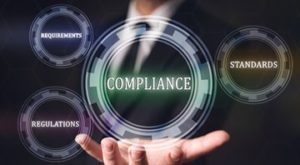January 25, 2022

How do businesses build a compliance culture? Here are some guidelines.
Make sure executives buy into the process.
For compliance to matter in the employee ranks, it must matter to executives. To send the appropriate messages regarding compliance, the executive team must talk about it often. Whenever appropriate, executives should pepper their verbal and written communications with topics relating to compliance. Make sure executives can make the case as to why compliance is an important goal for the company to pursue. For example, they should be able to explain the financial benefits of compliance in terms employees readily understand.
Invest in education.
For a compliance culture to exist, everyone must understand the types of regulations the company must comply with, including ever-changing regulatory expectations. To make sure they remain up-to-date on the latest regulations, some companies assign certain employees with the responsibility of keeping pace with changes in the regulatory environment. Others rely on suitably qualified third parties such as law firms or consultants to provide updates. Regardless of who keeps track of the changes in regulations, make sure the mechanisms exist to communicate changes in regulations throughout the organization before they take effect, which allows your employees time to adapt their approach to ensure compliance.
Provide a financial incentive.
To make sure executives commit the appropriate time and resources to compliance, executive performance should also be determined in part by the ability to comply with relevant mandates. Furthermore, consider extending the payment of financial incentives to the employee ranks in the form of spot bonuses that reward behavior that helps the organization achieve compliance.
Clearly define roles and responsibilities.
To foster a compliance culture, there should be clear lines of responsibility and ownership from the top of the organization to the bottom. Everyone must know their roles in ensuring compliance and be able to explain the ramifications of failing to do so. Set expectations early, as soon as employees join the organization. Make sure you impress upon them the importance of compliance. To that end, new hire and recurring employee training should include sections dedicated to compliance.
Make sure policies and procedures exist.
The appropriate policies and procedures must be in place and frequently circulated, read and acknowledged by everyone in the organization. As the compliance environment changes, there should be a process in place to update every document relating to compliance as appropriate. To support a compliance culture, internal controls must exist and be highly publicized. Furthermore, employees must know when and how to raise concerns regarding a failing control or alleged violation of the program. If someone violates a policy or procedure, companies must hold those individuals accountable.
Track and report violations.
The effectiveness of your compliance efforts hinges on your ability to track where the program excels and where it falls short. Creating a centralized compliance case management system allows your organization to develop a granular understanding of the compliance program strengths and weaknesses. The appropriate technology can also help track compliance failures and ensure consistency regarding the associated employee disciplinary decisions.
A Sustained Effort
In a compliance culture, compliance becomes part of everyday tasks instead of an afterthought. And while establishing and maintaining an effective culture requires a sustained effort, by doing so, your business can minimize compliance violations and the associated financial penalties and distractions they create.
© 2022